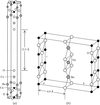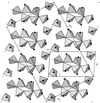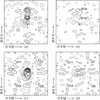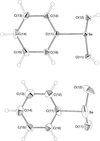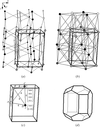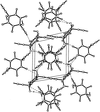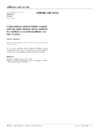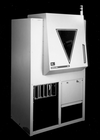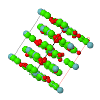issue contents
December 2000 issue

Cover illustration: Perspective view of the structure of the complex of 2,4,6-tris- (4-chlorophenoxy)-1,3,5-triazine with tribromobenzene, determined by neutron diffraction. Courtesy of J. A. K. Howard & C. K. Broder (University of Durham, UK), G. R. Desiraju, A. Nangia & R. K. R. Jetti (University of Hyderabad, India), C. C. Wilson & D. A. Keen (Rutherford Appleton Laboratory, Chilton, UK).
research papers
Download citation


Download citation


The twinned low-temperature monoclinic (P21) and orthorhombic (P212121) phases of the type I langbeinite Tl2Cd2(SO4)3 have been determined. The monoclinic phase shows pseudo-orthorhombic symmetry. The rotation of the SO4 tetrahedra in the orthorhombic phase seems to be continuous with that of the monoclinic one.
A method is proposed for determining erroneous crystal structures with a disconnected topology. This method was tested on a sample of structures from the Inorganic Crystal Structure Database.
Download citation


Download citation


Crystals of the triclinic type B structure of dysprosium disilicate are complexly twinned and dimensionally monoclinic. The type B structure has a linear cluster of triple [SiO4] tetrahedra and individual tetrahedra are moderately distorted, in agreement with revised structural data for holmium disilicate.
Download citation


Download citation


Download citation


Download citation


Calcium pyrophosphate hydrates contribute to the disease chondrocalcinosis (pseudogout). Here a new crystal structure of the second polymorph of the tetrahydrate has been determined. It has been shown to be monoclinic, not orthorhombic as earlier supposed, and to have specific features which contribute to the autoinhibition of growth in supersaturated solutions at pH 7.
The incommensurately modulated structure of the compound La2Co1.7, lanthanum cobaltide, was determined from neutron and X-ray single-crystal diffraction data collected at 15 K and room temperature. Two descriptions in the superspace formalism using the sawtooth function and the composite model were used to describe the periodicity of cobalt. The chemical composition was newly determined as La2Co1.8 (1).
Download citation


Download citation


The crystal structure of α-Cu7PSe6, one of the three polymorphic forms of the argyrodite Cu7PSe6 compound, is determined by means of single-crystal diffraction from twinned crystals and powder X-ray diffraction, with the help of NMR measurements. The analysis reveals a complete localization of copper in different low coordination selenium sites. The copper environment is examined and compared to the situation in β-Cu7PSe6 and the environment of silver in Ag7PSe6.
Download citation


Download citation


The synchrotron X-ray diffraction measurement of Sr/Cr- and Ba-doped KTP crystals show that the Ba dopant is positioned in the larger of the two K cavities while Sr is located in both cavities, whereas CrIII and CrVI are found inside the TiO6 octahedra.
Download citation


Download citation


The crystal structure of the rhombohedral modification of potassium hydrogensulfide which is stable between T = 101 and 426 K was investigated with neutron single-crystal diffraction at ambient temperature on the fully deuterated compound. A considerable anharmonicity of the deuterium atom potential was detected using a Gram-Charlier series to describe the thermal displacement of the atoms.
Download citation


Download citation


The crystal and molecular structure of a new copper(I) thiourea complex, [Cu (SC(NH
(SC(NH )
) )
) ](SO
](SO )
) H
H O, was determined. It is arranged as centrosymmetric [Cu
O, was determined. It is arranged as centrosymmetric [Cu (tu)
(tu) ]
] ions with a crown-like conformation.
ions with a crown-like conformation.
Download citation


Download citation


The structure of [Y(H2O)]2(C2O4)(CO3)2 is solved ab initio from powder and single-crystal diffraction data. The structure is compared to that of the related gadolinium compound with half a unit-cell volume.
Download citation


Download citation


The molecular rigid-body translations and librations in the structure of (hydroquinone)3C60 at four temperatures are determined from X-ray diffraction data.
Download citation


Download citation


An order–disorder transition and dimorphism in the title compound have been studied by X-ray crystallography. The molecules adopt U-shaped conformations which molecular mechanics confirm as the most stable.
A semi-quantitative bimodal model accounts for most cases of the N—H⋯N hydrogen-bond networks in 1H-unsubstituted pyrazoles (dimers, trimers, tetramers and chains). Ab initio calculations provided a basis for the model.
Download citation


Download citation


The dihydroxyselenonium ion has been structurally characterized in two aryl sulfonium salts and its pK value determined from 77Se chemical shifts.
The topological properties of molecular packings and molecular coordination numbers (MCNs) were determined in the crystal structures of 33 575 monosystem organic compounds. It is found that within the first coordination sphere most of the molecules tend to arrange with MCN = 14, but molecular packings as a whole tend to be constructed according to one of the close packings.
Download citation


Download citation


The structures of three acetoacetanilides and one related monoazo pigment are presented. Relationships and differences in terms of torsion angles, hydrogen bonding and steric factors are discussed.
Download citation


Download citation


Salt-like adducts of meso and racemic 5,5,7,12,12,14-hexamethyl-1,4,8,11-tetraazacyclotetradecane (tet-a and tet-b, respectively) with 5-hydroxyisophthalic acid contain very similar hydrogen-bonded sheet structures, despite the different configurations and conformations of the cations (meso versus racemic) and the different space groups. The salt-like adduct of tet-a with 3,5-dinitrobenzoic acid has a one-dimensional structure, a chain of rings.
Download citation


Download citation


In common with the parent molecule, structures of the tetrahalogenated derivatives are mediated by O—H⋯O hydrogen bonds, which form hexameric synthons in the fluoro compound, but tetrameric synthons in the chloro and bromo analogues. Differences in the overall structural architectures are due to the interplay between these strong interactions and a variety of weaker interactions involving the halogens, C—H donors and the ethynyl π-system.
Download citation


Download citation


Structures of four derivatives of diphenylethynylmethanol fail to form the expected strong O—H⋯O hydrogen bonds. Instead, the structures are mediated by weaker interactions involving O—H and C—H donors and hydroxy-O and π-acceptors, together with halogen⋯halogen interactions in the dichloro and dibromo derivatives.
Download citation


Download citation


The host triazine molecules form a two-dimensional hexagonal network via the Cl⋯Cl interactions of a triangular Cl3 synthon. Guest molecules are located in the hexagonal channels using C—Br⋯π and C—H⋯π interactions.
Download citation


Download citation


The crystal structure of the organic non-linear optical material 3-(1,1-dicyanoethenyl)-1-phenyl-4,5-dihydro-1H-pyrazole, DCNP, deduced by single-crystal neutron diffraction and variable-temperature X-ray diffraction studies, is presented. The hydrogen bonding and atomic thermal motion thus characterized are related to the physical properties of the material and the thermal expansivity coefficients of the material are evaluated.
Download citation


Download citation


Intermolecular interactions and molecular conformations are compared for diethylstilbestrol molecules in nine different solvate structures.
Download citation


Download citation


The crystal structures of β′-CLC and β′-MPM have been determined from single-crystal and high-resolution X-ray powder diffraction data, respectively. Furthermore, a comparison is made with existing models of β′-CnCn+2Cn triacylglycerols and with stable CnCnCn triacylclycerols
addenda and errata
Free 

new commercial products
Free 



 journal menu
journal menu












